Investigating Stress Corrosion Cracks in Australian Gas Pipelines
VerifiedAdded on 2020/05/11
|33
|6046
|173
Report
AI Summary
This report delves into the complex issue of stress corrosion cracks (SCC) in Australian gas pipelines. It begins with an abstract that highlights the challenges of detecting SCC and its impact on pipeline integrity, emphasizing the role of tensile pressure and corrosive environments. The report then presents a detailed literature review, analyzing various sources that discuss SCC in gas pipelines, including the Canadian Pipeline Association's survey on pipeline safety, Gomboa's study on inclined SCC, and investigations into the morphology and implications of SCC cracks. The literature review also covers topics such as the effects of high pH stress corrosion, stress corrosion in welded joints, and the role of pattern recognition techniques. The introduction outlines the significance of SCC in gas pipeline construction and operation, particularly in the context of transporting hazardous gases. The report poses the research question, 'What is the effect of SCC in the gas pipeline integration design?' and explores factors like chemical effects and heat treatment. The report highlights the importance of safety measures to protect the environment and recommends an effective management approach to mitigate SCC. The findings are crucial for the construction, maintenance, and safety of gas pipelines in Australia and beyond.

1
STRESS CORROSION CRACK in GAS PIPELINE in AUSTRALIA
STRESS CORROSION CRACK in GAS PIPELINE in AUSTRALIA
Paraphrase This Document
Need a fresh take? Get an instant paraphrase of this document with our AI Paraphraser
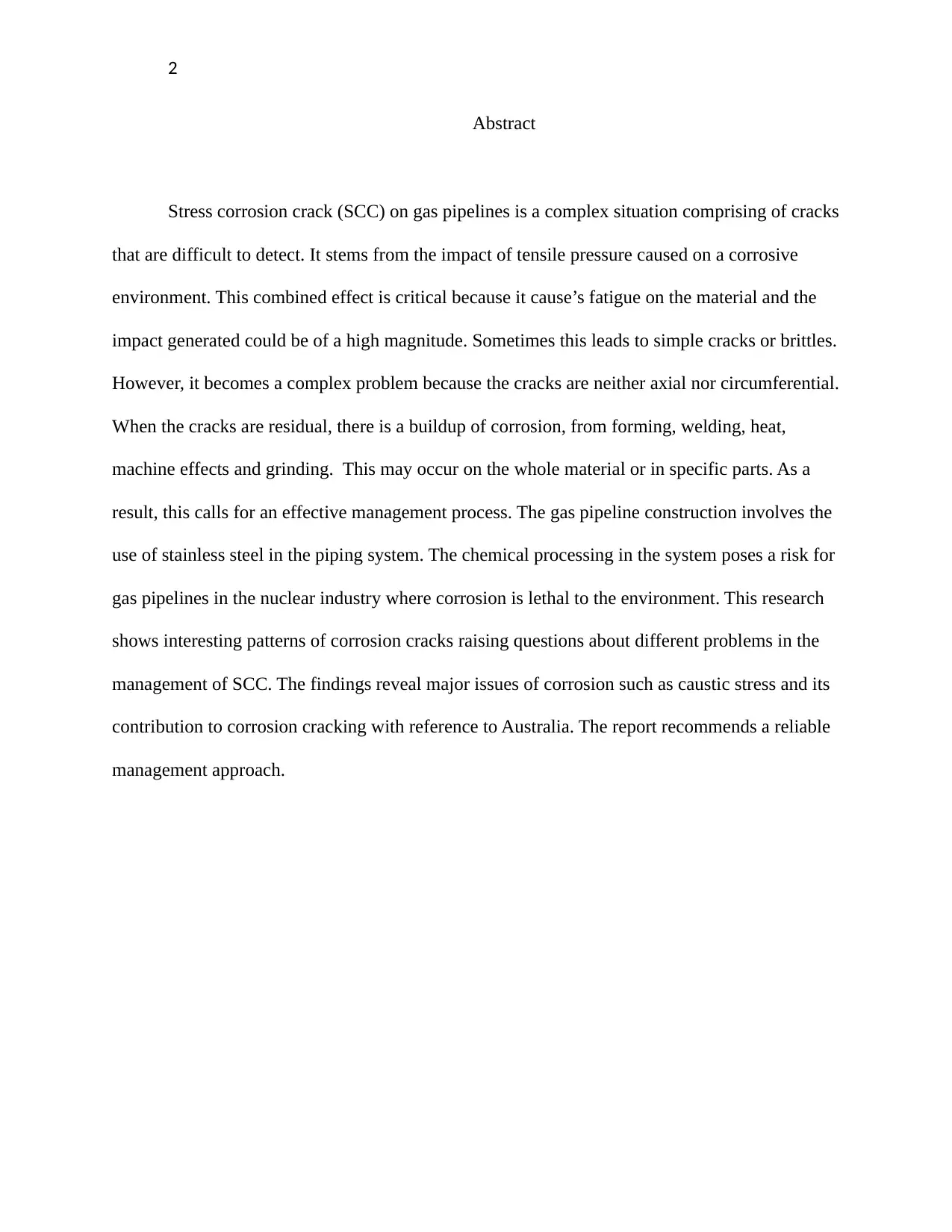
2
Abstract
Stress corrosion crack (SCC) on gas pipelines is a complex situation comprising of cracks
that are difficult to detect. It stems from the impact of tensile pressure caused on a corrosive
environment. This combined effect is critical because it cause’s fatigue on the material and the
impact generated could be of a high magnitude. Sometimes this leads to simple cracks or brittles.
However, it becomes a complex problem because the cracks are neither axial nor circumferential.
When the cracks are residual, there is a buildup of corrosion, from forming, welding, heat,
machine effects and grinding. This may occur on the whole material or in specific parts. As a
result, this calls for an effective management process. The gas pipeline construction involves the
use of stainless steel in the piping system. The chemical processing in the system poses a risk for
gas pipelines in the nuclear industry where corrosion is lethal to the environment. This research
shows interesting patterns of corrosion cracks raising questions about different problems in the
management of SCC. The findings reveal major issues of corrosion such as caustic stress and its
contribution to corrosion cracking with reference to Australia. The report recommends a reliable
management approach.
Abstract
Stress corrosion crack (SCC) on gas pipelines is a complex situation comprising of cracks
that are difficult to detect. It stems from the impact of tensile pressure caused on a corrosive
environment. This combined effect is critical because it cause’s fatigue on the material and the
impact generated could be of a high magnitude. Sometimes this leads to simple cracks or brittles.
However, it becomes a complex problem because the cracks are neither axial nor circumferential.
When the cracks are residual, there is a buildup of corrosion, from forming, welding, heat,
machine effects and grinding. This may occur on the whole material or in specific parts. As a
result, this calls for an effective management process. The gas pipeline construction involves the
use of stainless steel in the piping system. The chemical processing in the system poses a risk for
gas pipelines in the nuclear industry where corrosion is lethal to the environment. This research
shows interesting patterns of corrosion cracks raising questions about different problems in the
management of SCC. The findings reveal major issues of corrosion such as caustic stress and its
contribution to corrosion cracking with reference to Australia. The report recommends a reliable
management approach.

3
Table of Contents
Literature planner...............................................................................................................4
Introduction......................................................................................................................12
Literature Review............................................................................................................ 12
Critique of Literature source........................................................................................20
Research Design.............................................................................................................. 22
Research Question....................................................................................................... 23
Related Work............................................................................................................... 24
Ethical Consideration...................................................................................................27
Conclusion and Recommendations..................................................................................28
References........................................................................................................................30
Table of Contents
Literature planner...............................................................................................................4
Introduction......................................................................................................................12
Literature Review............................................................................................................ 12
Critique of Literature source........................................................................................20
Research Design.............................................................................................................. 22
Research Question....................................................................................................... 23
Related Work............................................................................................................... 24
Ethical Consideration...................................................................................................27
Conclusion and Recommendations..................................................................................28
References........................................................................................................................30
⊘ This is a preview!⊘
Do you want full access?
Subscribe today to unlock all pages.

Trusted by 1+ million students worldwide
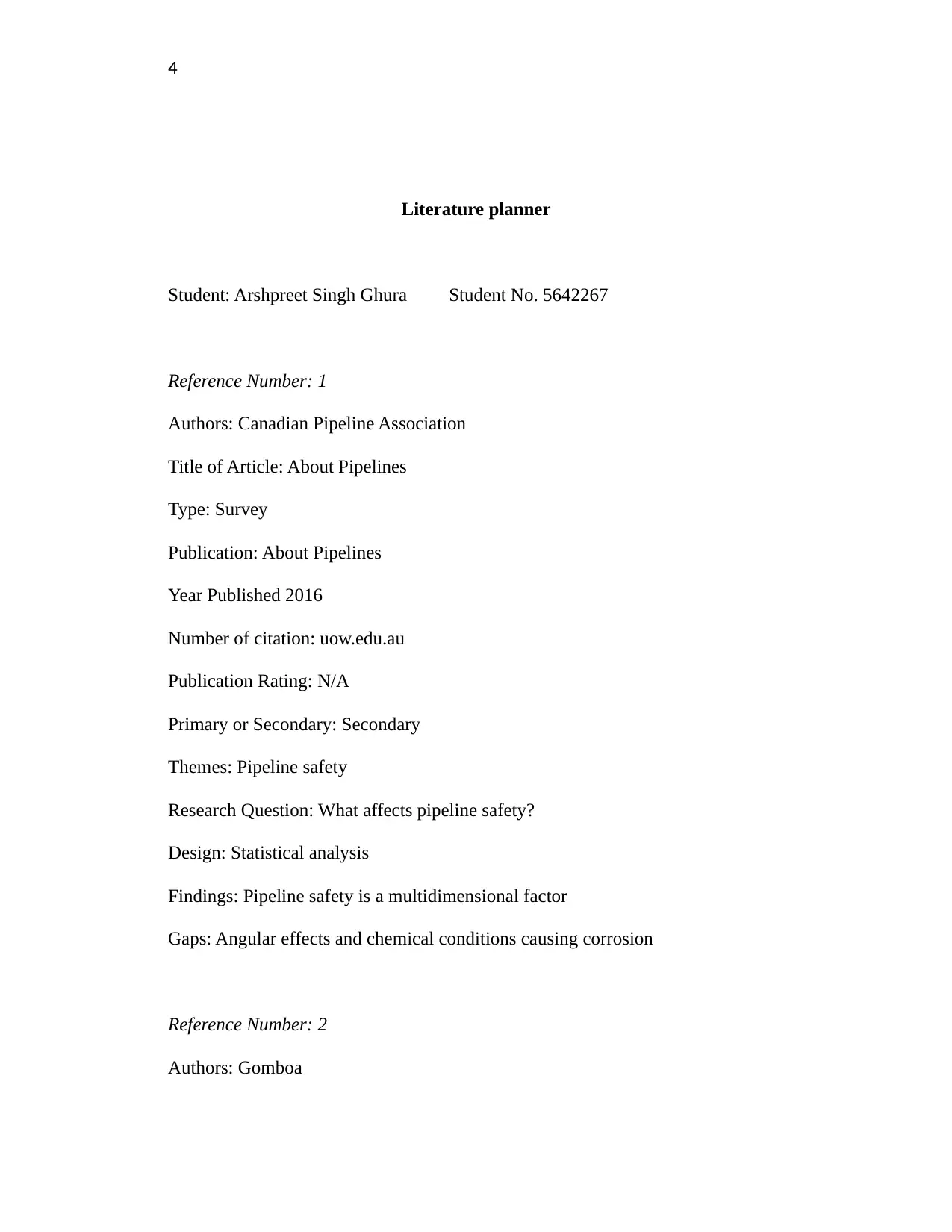
4
Literature planner
Student: Arshpreet Singh Ghura Student No. 5642267
Reference Number: 1
Authors: Canadian Pipeline Association
Title of Article: About Pipelines
Type: Survey
Publication: About Pipelines
Year Published 2016
Number of citation: uow.edu.au
Publication Rating: N/A
Primary or Secondary: Secondary
Themes: Pipeline safety
Research Question: What affects pipeline safety?
Design: Statistical analysis
Findings: Pipeline safety is a multidimensional factor
Gaps: Angular effects and chemical conditions causing corrosion
Reference Number: 2
Authors: Gomboa
Literature planner
Student: Arshpreet Singh Ghura Student No. 5642267
Reference Number: 1
Authors: Canadian Pipeline Association
Title of Article: About Pipelines
Type: Survey
Publication: About Pipelines
Year Published 2016
Number of citation: uow.edu.au
Publication Rating: N/A
Primary or Secondary: Secondary
Themes: Pipeline safety
Research Question: What affects pipeline safety?
Design: Statistical analysis
Findings: Pipeline safety is a multidimensional factor
Gaps: Angular effects and chemical conditions causing corrosion
Reference Number: 2
Authors: Gomboa
Paraphrase This Document
Need a fresh take? Get an instant paraphrase of this document with our AI Paraphraser
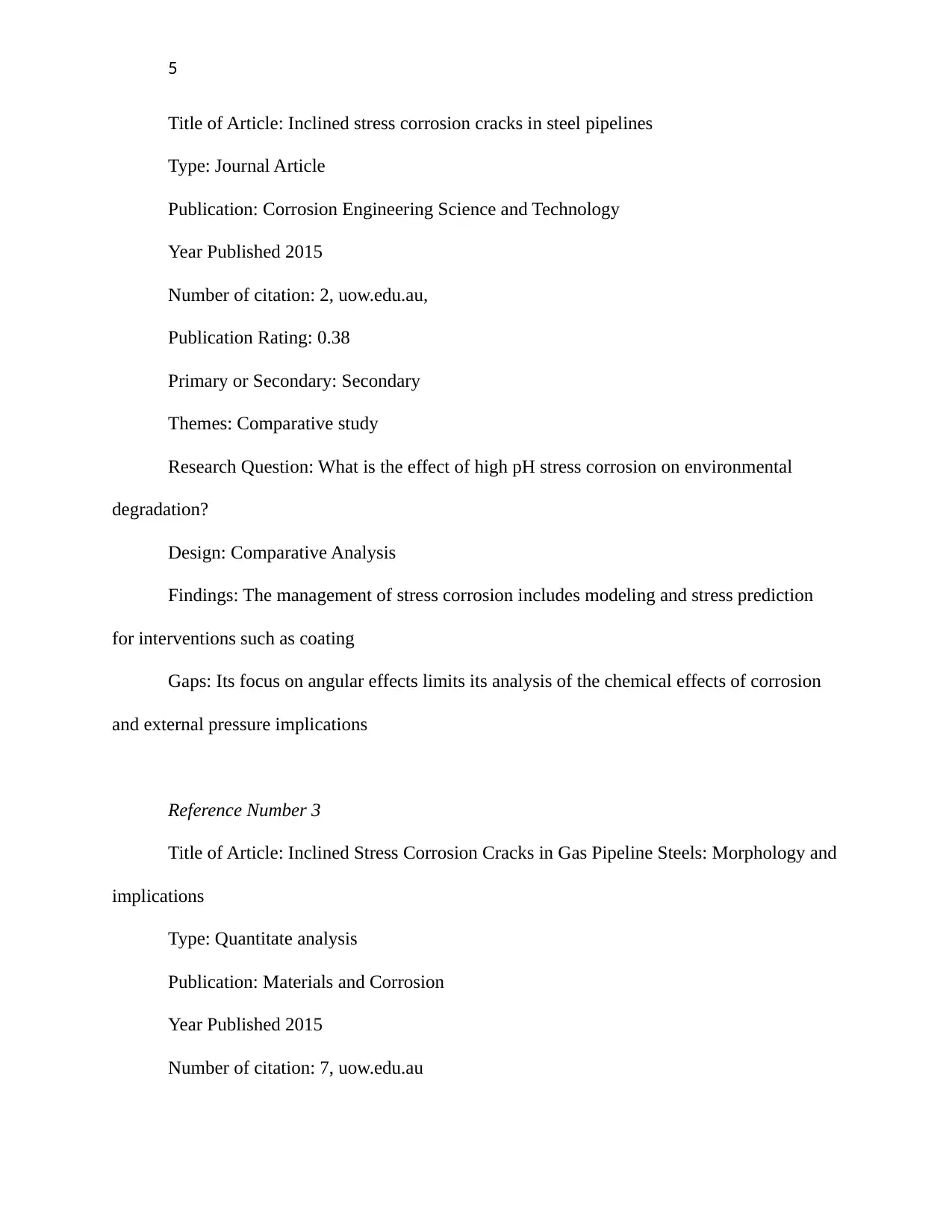
5
Title of Article: Inclined stress corrosion cracks in steel pipelines
Type: Journal Article
Publication: Corrosion Engineering Science and Technology
Year Published 2015
Number of citation: 2, uow.edu.au,
Publication Rating: 0.38
Primary or Secondary: Secondary
Themes: Comparative study
Research Question: What is the effect of high pH stress corrosion on environmental
degradation?
Design: Comparative Analysis
Findings: The management of stress corrosion includes modeling and stress prediction
for interventions such as coating
Gaps: Its focus on angular effects limits its analysis of the chemical effects of corrosion
and external pressure implications
Reference Number 3
Title of Article: Inclined Stress Corrosion Cracks in Gas Pipeline Steels: Morphology and
implications
Type: Quantitate analysis
Publication: Materials and Corrosion
Year Published 2015
Number of citation: 7, uow.edu.au
Title of Article: Inclined stress corrosion cracks in steel pipelines
Type: Journal Article
Publication: Corrosion Engineering Science and Technology
Year Published 2015
Number of citation: 2, uow.edu.au,
Publication Rating: 0.38
Primary or Secondary: Secondary
Themes: Comparative study
Research Question: What is the effect of high pH stress corrosion on environmental
degradation?
Design: Comparative Analysis
Findings: The management of stress corrosion includes modeling and stress prediction
for interventions such as coating
Gaps: Its focus on angular effects limits its analysis of the chemical effects of corrosion
and external pressure implications
Reference Number 3
Title of Article: Inclined Stress Corrosion Cracks in Gas Pipeline Steels: Morphology and
implications
Type: Quantitate analysis
Publication: Materials and Corrosion
Year Published 2015
Number of citation: 7, uow.edu.au
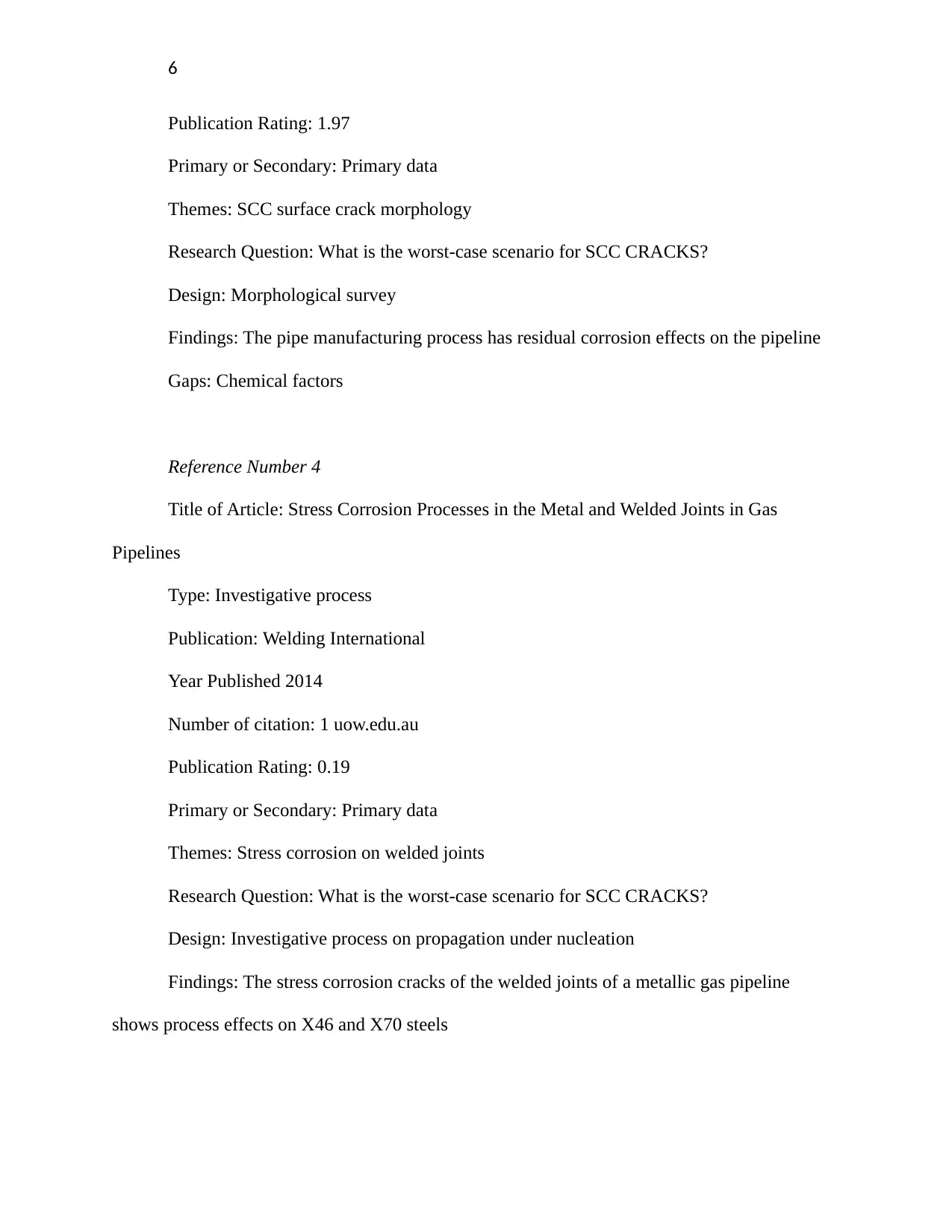
6
Publication Rating: 1.97
Primary or Secondary: Primary data
Themes: SCC surface crack morphology
Research Question: What is the worst-case scenario for SCC CRACKS?
Design: Morphological survey
Findings: The pipe manufacturing process has residual corrosion effects on the pipeline
Gaps: Chemical factors
Reference Number 4
Title of Article: Stress Corrosion Processes in the Metal and Welded Joints in Gas
Pipelines
Type: Investigative process
Publication: Welding International
Year Published 2014
Number of citation: 1 uow.edu.au
Publication Rating: 0.19
Primary or Secondary: Primary data
Themes: Stress corrosion on welded joints
Research Question: What is the worst-case scenario for SCC CRACKS?
Design: Investigative process on propagation under nucleation
Findings: The stress corrosion cracks of the welded joints of a metallic gas pipeline
shows process effects on X46 and X70 steels
Publication Rating: 1.97
Primary or Secondary: Primary data
Themes: SCC surface crack morphology
Research Question: What is the worst-case scenario for SCC CRACKS?
Design: Morphological survey
Findings: The pipe manufacturing process has residual corrosion effects on the pipeline
Gaps: Chemical factors
Reference Number 4
Title of Article: Stress Corrosion Processes in the Metal and Welded Joints in Gas
Pipelines
Type: Investigative process
Publication: Welding International
Year Published 2014
Number of citation: 1 uow.edu.au
Publication Rating: 0.19
Primary or Secondary: Primary data
Themes: Stress corrosion on welded joints
Research Question: What is the worst-case scenario for SCC CRACKS?
Design: Investigative process on propagation under nucleation
Findings: The stress corrosion cracks of the welded joints of a metallic gas pipeline
shows process effects on X46 and X70 steels
⊘ This is a preview!⊘
Do you want full access?
Subscribe today to unlock all pages.

Trusted by 1+ million students worldwide

7
Gaps: The focus is on welding and it ignores other risk management factors in oil and gas
such as coating and infrastructural modeling.
Reference Number 5
Title of Article: Pipeline Corrosion
Type: Qualitative analysis
Publication: Corrosion Engineering Science and Technology
Year Published 2015
Number of citation: 1, uow.edu.au
Publication Rating: 2.82
Primary or Secondary: Secondary data on pipeline corrosion
Themes: internal and external corrosion, inspection technique, corrosion modeling
Research Question: What is the interaction effect between the biofilm and the metal
components of a gas pipeline?
Design: Analysis of maintenance techniques
Findings: There are internal factors of SCC caused by synergies in tensile pressure and
the corrosive environment as well as the steel metallurgy.
Gaps: Its focus is mainly on the mechanical but there are also practical factors
contributing to SCC such as technology prediction.
Reference Number: 6
Authors: Gopalakrishnan, J; Agnihotri, G; Deshpande, D, M;
Title of Article: Virtual Instrumentation Corrosion Controller for Natural Gas Pipelines
Gaps: The focus is on welding and it ignores other risk management factors in oil and gas
such as coating and infrastructural modeling.
Reference Number 5
Title of Article: Pipeline Corrosion
Type: Qualitative analysis
Publication: Corrosion Engineering Science and Technology
Year Published 2015
Number of citation: 1, uow.edu.au
Publication Rating: 2.82
Primary or Secondary: Secondary data on pipeline corrosion
Themes: internal and external corrosion, inspection technique, corrosion modeling
Research Question: What is the interaction effect between the biofilm and the metal
components of a gas pipeline?
Design: Analysis of maintenance techniques
Findings: There are internal factors of SCC caused by synergies in tensile pressure and
the corrosive environment as well as the steel metallurgy.
Gaps: Its focus is mainly on the mechanical but there are also practical factors
contributing to SCC such as technology prediction.
Reference Number: 6
Authors: Gopalakrishnan, J; Agnihotri, G; Deshpande, D, M;
Title of Article: Virtual Instrumentation Corrosion Controller for Natural Gas Pipelines
Paraphrase This Document
Need a fresh take? Get an instant paraphrase of this document with our AI Paraphraser
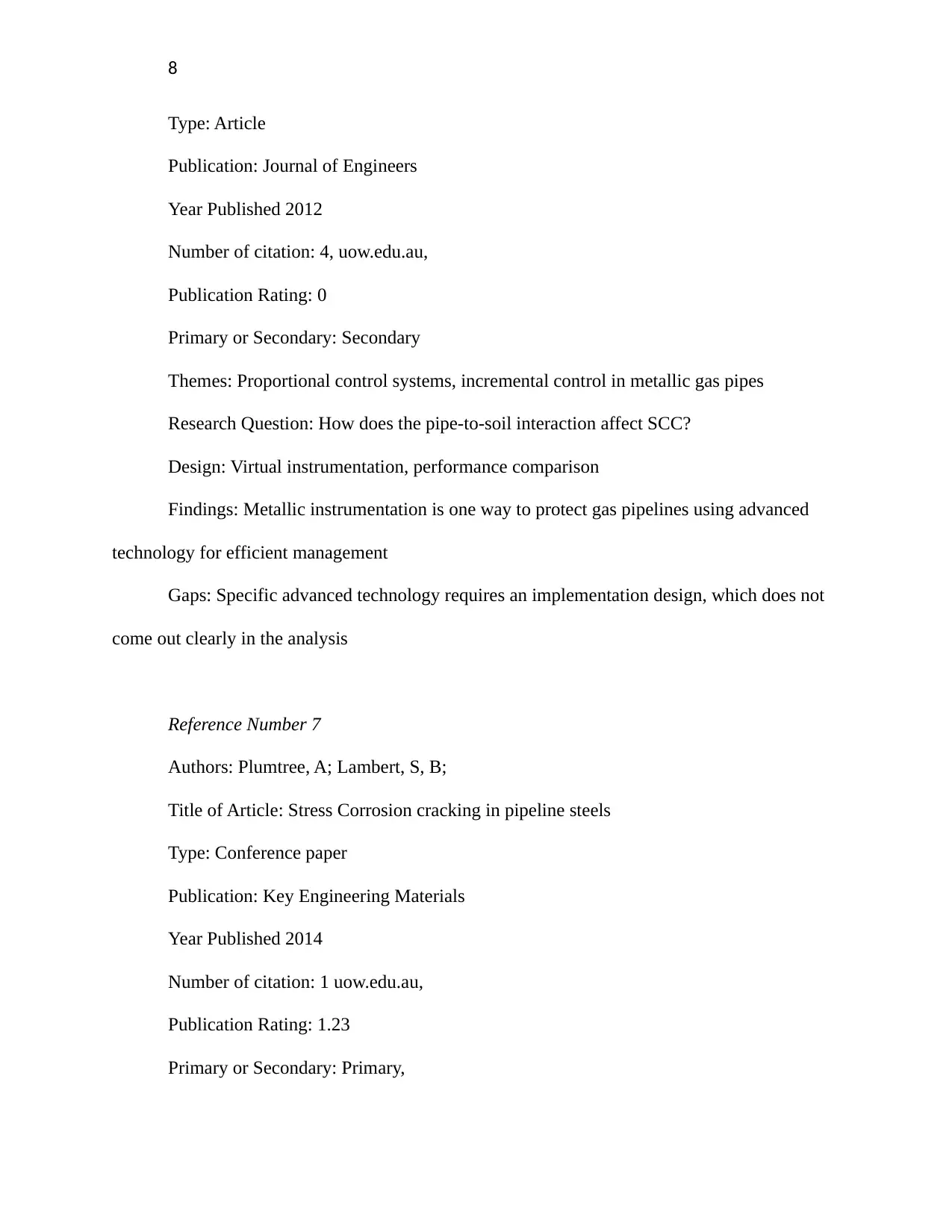
8
Type: Article
Publication: Journal of Engineers
Year Published 2012
Number of citation: 4, uow.edu.au,
Publication Rating: 0
Primary or Secondary: Secondary
Themes: Proportional control systems, incremental control in metallic gas pipes
Research Question: How does the pipe-to-soil interaction affect SCC?
Design: Virtual instrumentation, performance comparison
Findings: Metallic instrumentation is one way to protect gas pipelines using advanced
technology for efficient management
Gaps: Specific advanced technology requires an implementation design, which does not
come out clearly in the analysis
Reference Number 7
Authors: Plumtree, A; Lambert, S, B;
Title of Article: Stress Corrosion cracking in pipeline steels
Type: Conference paper
Publication: Key Engineering Materials
Year Published 2014
Number of citation: 1 uow.edu.au,
Publication Rating: 1.23
Primary or Secondary: Primary,
Type: Article
Publication: Journal of Engineers
Year Published 2012
Number of citation: 4, uow.edu.au,
Publication Rating: 0
Primary or Secondary: Secondary
Themes: Proportional control systems, incremental control in metallic gas pipes
Research Question: How does the pipe-to-soil interaction affect SCC?
Design: Virtual instrumentation, performance comparison
Findings: Metallic instrumentation is one way to protect gas pipelines using advanced
technology for efficient management
Gaps: Specific advanced technology requires an implementation design, which does not
come out clearly in the analysis
Reference Number 7
Authors: Plumtree, A; Lambert, S, B;
Title of Article: Stress Corrosion cracking in pipeline steels
Type: Conference paper
Publication: Key Engineering Materials
Year Published 2014
Number of citation: 1 uow.edu.au,
Publication Rating: 1.23
Primary or Secondary: Primary,
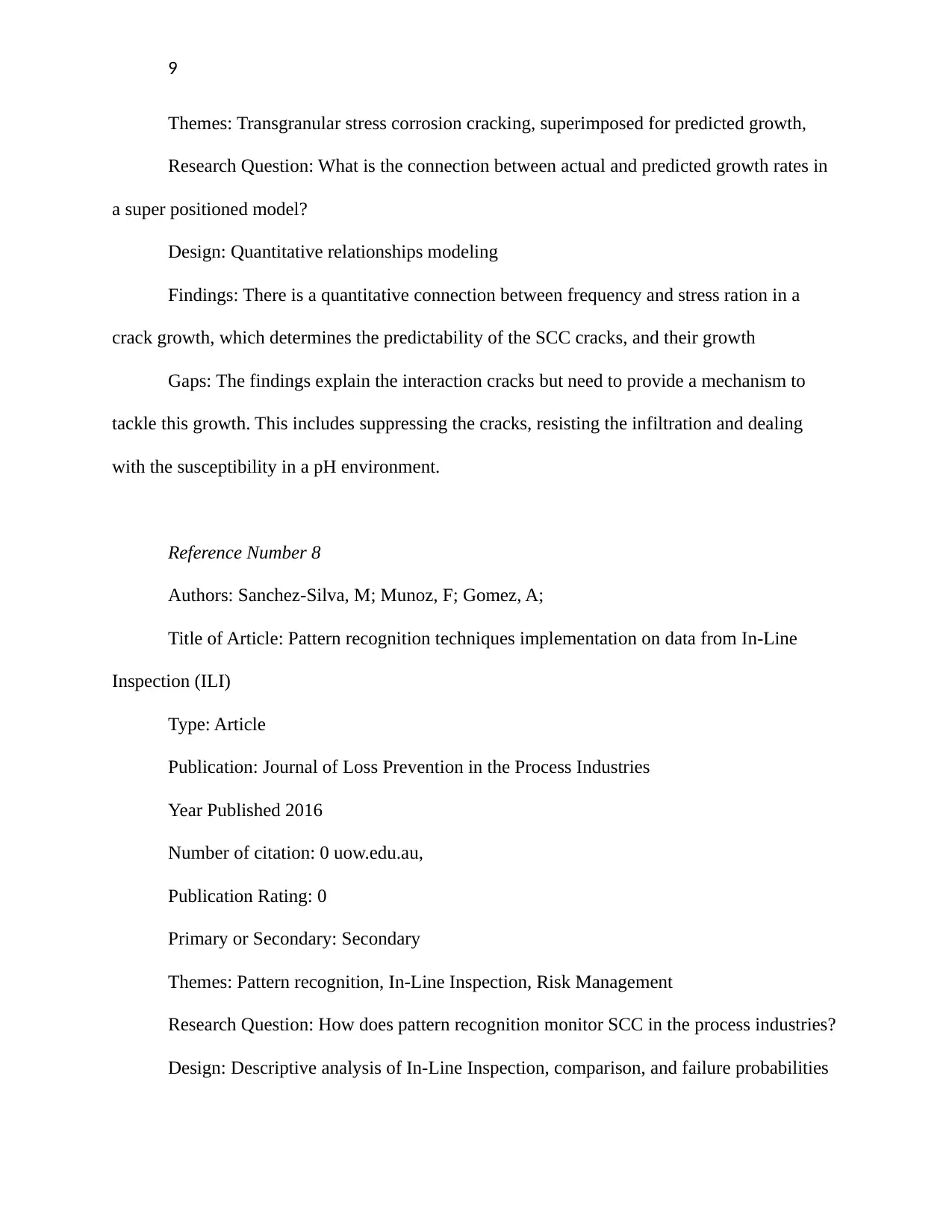
9
Themes: Transgranular stress corrosion cracking, superimposed for predicted growth,
Research Question: What is the connection between actual and predicted growth rates in
a super positioned model?
Design: Quantitative relationships modeling
Findings: There is a quantitative connection between frequency and stress ration in a
crack growth, which determines the predictability of the SCC cracks, and their growth
Gaps: The findings explain the interaction cracks but need to provide a mechanism to
tackle this growth. This includes suppressing the cracks, resisting the infiltration and dealing
with the susceptibility in a pH environment.
Reference Number 8
Authors: Sanchez-Silva, M; Munoz, F; Gomez, A;
Title of Article: Pattern recognition techniques implementation on data from In-Line
Inspection (ILI)
Type: Article
Publication: Journal of Loss Prevention in the Process Industries
Year Published 2016
Number of citation: 0 uow.edu.au,
Publication Rating: 0
Primary or Secondary: Secondary
Themes: Pattern recognition, In-Line Inspection, Risk Management
Research Question: How does pattern recognition monitor SCC in the process industries?
Design: Descriptive analysis of In-Line Inspection, comparison, and failure probabilities
Themes: Transgranular stress corrosion cracking, superimposed for predicted growth,
Research Question: What is the connection between actual and predicted growth rates in
a super positioned model?
Design: Quantitative relationships modeling
Findings: There is a quantitative connection between frequency and stress ration in a
crack growth, which determines the predictability of the SCC cracks, and their growth
Gaps: The findings explain the interaction cracks but need to provide a mechanism to
tackle this growth. This includes suppressing the cracks, resisting the infiltration and dealing
with the susceptibility in a pH environment.
Reference Number 8
Authors: Sanchez-Silva, M; Munoz, F; Gomez, A;
Title of Article: Pattern recognition techniques implementation on data from In-Line
Inspection (ILI)
Type: Article
Publication: Journal of Loss Prevention in the Process Industries
Year Published 2016
Number of citation: 0 uow.edu.au,
Publication Rating: 0
Primary or Secondary: Secondary
Themes: Pattern recognition, In-Line Inspection, Risk Management
Research Question: How does pattern recognition monitor SCC in the process industries?
Design: Descriptive analysis of In-Line Inspection, comparison, and failure probabilities
⊘ This is a preview!⊘
Do you want full access?
Subscribe today to unlock all pages.

Trusted by 1+ million students worldwide

10
Findings: ILI measurements provide reliable data and patterns for cycle analysis in
clustering
Gaps: The ILI is ideal for liquid gas elements leaving gaps for the natural gas mechanism
Reference Number 9
Authors: Staehle, R, W; Ru, X;
Title of Article: Historical experience providing bases for predicting corrosion and stress
corrosion in emerging superficial water nuclear technology, Part 1-Review
Type: Review
Publication: Corrosion
Year Published 2013
Number of citation: 10 uow.edu.au,
Publication Rating: 0.33
Primary or Secondary: Secondary
Themes: Temperature dependencies, corrosion, stress corrosion, cracking, embrittlement,
nuclear reactors
Research Question: What is the base for predicting corrosion and stress corrosion in
emerging superficial water nuclear technology?
Design: Systematic review of correlational historical data analysis
Findings: The development and operation of superficial water reactor (SCWR) provide
data that is applicable in superheated nuclear plants and supercritical fossil plants. The findings
guide the choice of material for cores structure
Findings: ILI measurements provide reliable data and patterns for cycle analysis in
clustering
Gaps: The ILI is ideal for liquid gas elements leaving gaps for the natural gas mechanism
Reference Number 9
Authors: Staehle, R, W; Ru, X;
Title of Article: Historical experience providing bases for predicting corrosion and stress
corrosion in emerging superficial water nuclear technology, Part 1-Review
Type: Review
Publication: Corrosion
Year Published 2013
Number of citation: 10 uow.edu.au,
Publication Rating: 0.33
Primary or Secondary: Secondary
Themes: Temperature dependencies, corrosion, stress corrosion, cracking, embrittlement,
nuclear reactors
Research Question: What is the base for predicting corrosion and stress corrosion in
emerging superficial water nuclear technology?
Design: Systematic review of correlational historical data analysis
Findings: The development and operation of superficial water reactor (SCWR) provide
data that is applicable in superheated nuclear plants and supercritical fossil plants. The findings
guide the choice of material for cores structure
Paraphrase This Document
Need a fresh take? Get an instant paraphrase of this document with our AI Paraphraser
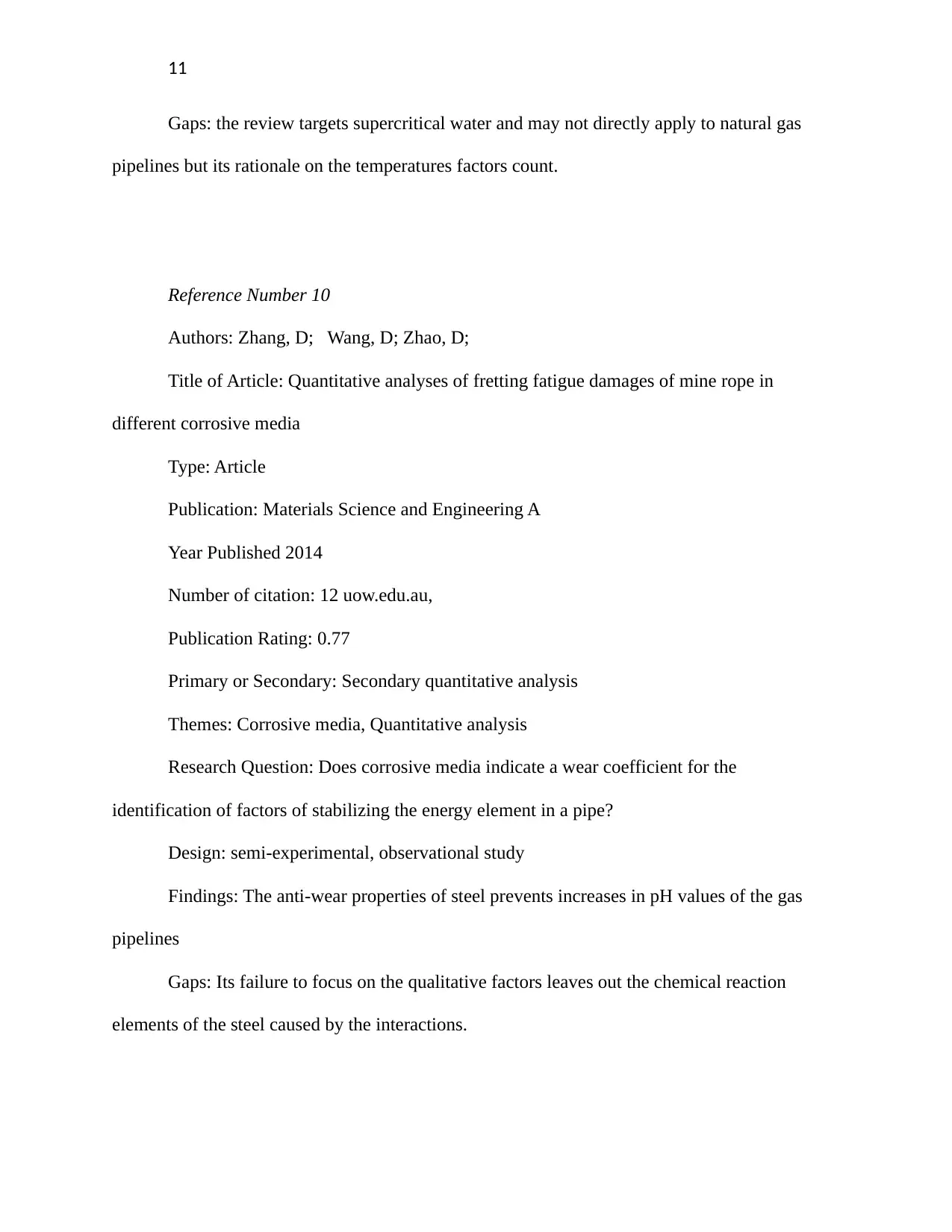
11
Gaps: the review targets supercritical water and may not directly apply to natural gas
pipelines but its rationale on the temperatures factors count.
Reference Number 10
Authors: Zhang, D; Wang, D; Zhao, D;
Title of Article: Quantitative analyses of fretting fatigue damages of mine rope in
different corrosive media
Type: Article
Publication: Materials Science and Engineering A
Year Published 2014
Number of citation: 12 uow.edu.au,
Publication Rating: 0.77
Primary or Secondary: Secondary quantitative analysis
Themes: Corrosive media, Quantitative analysis
Research Question: Does corrosive media indicate a wear coefficient for the
identification of factors of stabilizing the energy element in a pipe?
Design: semi-experimental, observational study
Findings: The anti-wear properties of steel prevents increases in pH values of the gas
pipelines
Gaps: Its failure to focus on the qualitative factors leaves out the chemical reaction
elements of the steel caused by the interactions.
Gaps: the review targets supercritical water and may not directly apply to natural gas
pipelines but its rationale on the temperatures factors count.
Reference Number 10
Authors: Zhang, D; Wang, D; Zhao, D;
Title of Article: Quantitative analyses of fretting fatigue damages of mine rope in
different corrosive media
Type: Article
Publication: Materials Science and Engineering A
Year Published 2014
Number of citation: 12 uow.edu.au,
Publication Rating: 0.77
Primary or Secondary: Secondary quantitative analysis
Themes: Corrosive media, Quantitative analysis
Research Question: Does corrosive media indicate a wear coefficient for the
identification of factors of stabilizing the energy element in a pipe?
Design: semi-experimental, observational study
Findings: The anti-wear properties of steel prevents increases in pH values of the gas
pipelines
Gaps: Its failure to focus on the qualitative factors leaves out the chemical reaction
elements of the steel caused by the interactions.
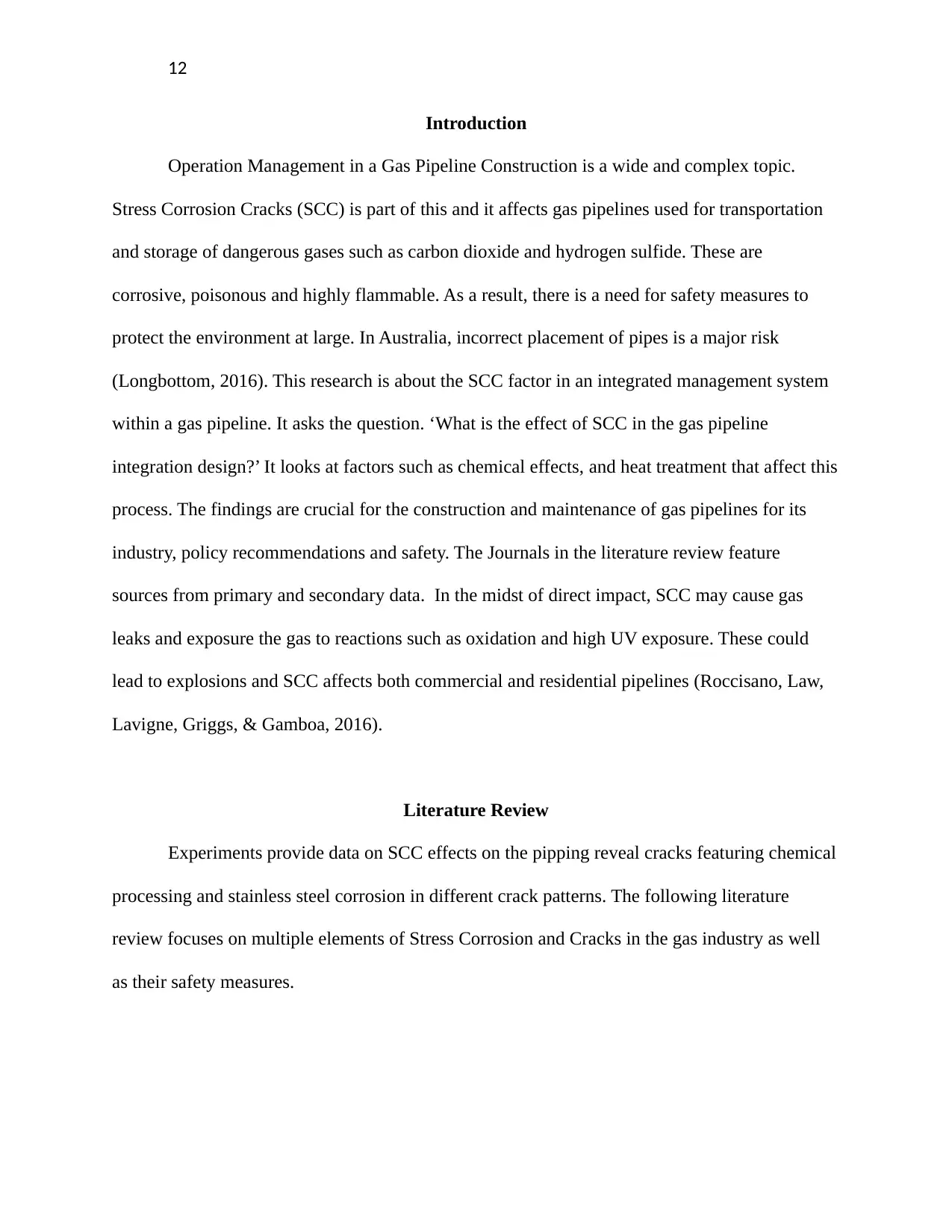
12
Introduction
Operation Management in a Gas Pipeline Construction is a wide and complex topic.
Stress Corrosion Cracks (SCC) is part of this and it affects gas pipelines used for transportation
and storage of dangerous gases such as carbon dioxide and hydrogen sulfide. These are
corrosive, poisonous and highly flammable. As a result, there is a need for safety measures to
protect the environment at large. In Australia, incorrect placement of pipes is a major risk
(Longbottom, 2016). This research is about the SCC factor in an integrated management system
within a gas pipeline. It asks the question. ‘What is the effect of SCC in the gas pipeline
integration design?’ It looks at factors such as chemical effects, and heat treatment that affect this
process. The findings are crucial for the construction and maintenance of gas pipelines for its
industry, policy recommendations and safety. The Journals in the literature review feature
sources from primary and secondary data. In the midst of direct impact, SCC may cause gas
leaks and exposure the gas to reactions such as oxidation and high UV exposure. These could
lead to explosions and SCC affects both commercial and residential pipelines (Roccisano, Law,
Lavigne, Griggs, & Gamboa, 2016).
Literature Review
Experiments provide data on SCC effects on the pipping reveal cracks featuring chemical
processing and stainless steel corrosion in different crack patterns. The following literature
review focuses on multiple elements of Stress Corrosion and Cracks in the gas industry as well
as their safety measures.
Introduction
Operation Management in a Gas Pipeline Construction is a wide and complex topic.
Stress Corrosion Cracks (SCC) is part of this and it affects gas pipelines used for transportation
and storage of dangerous gases such as carbon dioxide and hydrogen sulfide. These are
corrosive, poisonous and highly flammable. As a result, there is a need for safety measures to
protect the environment at large. In Australia, incorrect placement of pipes is a major risk
(Longbottom, 2016). This research is about the SCC factor in an integrated management system
within a gas pipeline. It asks the question. ‘What is the effect of SCC in the gas pipeline
integration design?’ It looks at factors such as chemical effects, and heat treatment that affect this
process. The findings are crucial for the construction and maintenance of gas pipelines for its
industry, policy recommendations and safety. The Journals in the literature review feature
sources from primary and secondary data. In the midst of direct impact, SCC may cause gas
leaks and exposure the gas to reactions such as oxidation and high UV exposure. These could
lead to explosions and SCC affects both commercial and residential pipelines (Roccisano, Law,
Lavigne, Griggs, & Gamboa, 2016).
Literature Review
Experiments provide data on SCC effects on the pipping reveal cracks featuring chemical
processing and stainless steel corrosion in different crack patterns. The following literature
review focuses on multiple elements of Stress Corrosion and Cracks in the gas industry as well
as their safety measures.
⊘ This is a preview!⊘
Do you want full access?
Subscribe today to unlock all pages.

Trusted by 1+ million students worldwide
1 out of 33
Related Documents
Your All-in-One AI-Powered Toolkit for Academic Success.
+13062052269
info@desklib.com
Available 24*7 on WhatsApp / Email
![[object Object]](/_next/static/media/star-bottom.7253800d.svg)
Unlock your academic potential
Copyright © 2020–2025 A2Z Services. All Rights Reserved. Developed and managed by ZUCOL.




